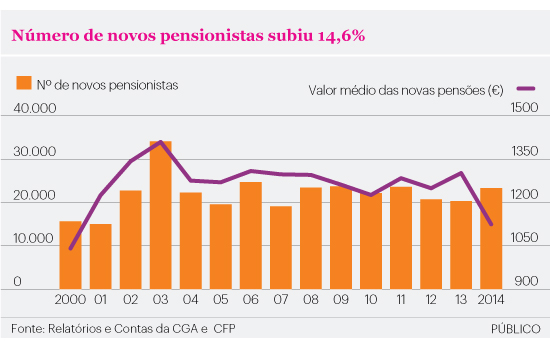The unprecedented fall of 13.1% in the average value of new pensions paid by the General Pension Fund (CGA) did not prevent an increase in the output flow of state workers. Last year, the number of new retirees increased 14.6% to more than 23,000, reversing the downward trend of the previous two years.
Changes in the pension calculation formula of the state and the sustainability factor was decisive for the amount of new pensions paid by the CGA in 2014 has been an unprecedented fall. On average, according to a Council report on public finance (CFP) released yesterday, civil servants who retired last year had a pension of 1,124.20 euros per month, ie 13.1% less than in 2013. To find a lower value is necessary to go back to 2000. The average pension paid that year was 1040.80 euros, down 9.5% over the previous year, explained by changes introduced in the calculation formula (now taking as reference 90% of salary, instead of 100%).
But while the retirement conditions have worsened, this has not lead to fewer workers decide to retire. On the contrary, the report notes “the strong growth in the number of new retirement pensioners.” Between January and December, the CGA registered 23,300 new retirees, an increase of 14.6% over the previous year, interrupting the downward trend of the previous two years.
In analyzing the budget implementation of the Social Security and CGA in 2014, the CFP points out that “this behavior suggests that the discretionary measures to increase the retirement age and strengthen the criminalization of early retirement (via reformulation of the sustainability factor), implemented in 2014, had a limited effect on changes in the number of new pensions. “
In 2014, the pension calculation formula for civil servants enrolled in the CGA until August 31, 1993 has been changed and the first installment of the pension began to take into account 80 % of the relevant remuneration (when even then it was 90%). In addition, the legal retirement age rose from 65 to 66 years old, having also aggravated the sustainability factor to be applied to pensions. In practice, who retired early had higher courts to those who would have previously.
 >
>
The CFP notes that the CGA actual expenditure grew by 2.5% (+ EUR 232 million), which contributed this increase in the number of new pensioners. The recipe had a similar increase of 2.5% (+ EUR 230 million), mainly at the expense increased contributions, through the rise of the contribution rate of employers (20% to 23.75%) and Contribution Extraordinary Solidarity (CES).
Similar to what happened in 2014, highlights the CFP, the evolution of the CGA the budgetary situation in 2015 will depend on the combined effect of opposite sign measures affecting both the revenue, or the expense of the system. On the revenue side, the increase in the reserve base of contributions and dues, due to the partial replacement of reduced remuneration since January, may be offset by a reduction in the number of subscribers, since the system is closed to new entries since 2005. Spending should maintain the growth path, “reflecting the progressive increase in the number of pensioners, whose impact can be mitigated by the effect of the new pension reconfiguring the sustainability factor that occurred in 2014″.
The council headed by Teodora Cardoso also looked at the evolution of Social Security and concluded that, excluding the extraordinary transfer of state budget (EUR 1329 million), continued to show a financial imbalance of 699 million. Notes, however, that the result reflects “a positive development both for the expected in the second amendment to the social security budget for 2014, either over the previous year, marking a reversal of the trend of recent years.”
In relation to 2015, the CFP leaves some alarms, particularly at the level of recovery expected revenue in terms of contributions and dues. Thus, these risks still may be compensated “by the positive effect due to an expense of running with unemployment benefits in 2014 lower than expected in conjunction with maintaining a downward trend perspective, in line with forecasts for the unemployment rate” .
No comments:
Post a Comment